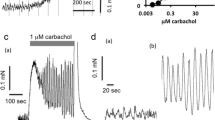Abstract
Possible differences in the abilities of esophageal body and lower esophageal sphincter muscles to utilize substrates to support agonist-induced contractions were studied. Strips of longitudinal, circular, and lower esophageal sphincter muscle from the opossum esophagus were first contracted to approximately 70% of the maximal contraction elicited by acetylcholine, histamine, or substance P. The tissues were then exhausted by exposure to 5×10−4 M carbachol and a 15% O2-5% CO2-80% N2 gas mixture for 90 min. They were next reequilibrated with one of a number of alternative substrates and 95% O2-5% CO2 for 3 hr. Responses to the initial agonist doses were again noted and compared to controls. The alternative substrates were: 2-deoxyglucose, glucose, fructose 1–6 diphosphate, pyruvate, lactate, acetate, butyrate, caprylate, histidine, leucine, aspartate, alanine, succinate, acetoacetone, and β-hydroxybutyrate. The results obtained show qualitative differences in the ability of the three muscle types to use these substrates. More importantly, however, the ability of any one substrate to support contractions was a function of the agonist used to stimulate the muscle. The evidence suggests, therefore, that not all pharmacologic receptors have equal access to intracellular energy sources.
Similar content being viewed by others
References
Christensen J: The esophagus.In A Guide To Gastrointestinal Motility, J Christensen, DL Wingate (eds) Bristol, England, John Wright & Sons, 1983, pp 198–224.
Schulze-Delrieu K, Crane SA: Oxygen uptake and mechanical tension in esophageal smooth muscle from opossums and cats. Am J Physiol 242:G258-G262, 1982
Prasad R, Mukhopadyay A, Prasad N: Variations in the lactate dehydrogenase activity in the esophagus. Experientia 34:484–485, 1978
Robison BA, Percy WH, Christensen J: Differences in cytochromec oxidase capacity in smooth muscle of opossum esophagus and lower esophageal sphincter. Gastroenterology 87:1009–1013, 1984
Christensen J, Roberts RL: Differences between esophageal body and lower esophageal sphincter in mitochondria of smooth muscle in opossum. Gastroenterology 85:650–656, 1983
Feldberg W, Solandt OM: The effects of drugs, sugars and allied substances on the isolated small intestine of the rabbit. J Physiol (London) 101:137–171, 1942
Furchgott RF: The effect of sodium fluoroacetate on the contractility and metabolism of intestinal smooth muscle. J Pharmacol Exp Ther 99:1–15, 1950
Furchgott RF, Schorr E: Sources of energy for intestinal smooth muscle contraction. Proc Soc Exp Biol Med 61:280–286, 1946
Furchgott RF, Wales M: Effect of pH on contractile activity of intestinal smooth muscle with and without added substrates. Am J Physiol 167:386–398, 1951
Furchgott RF, Wales M: Utilization of succinate and α-ketoglutarate for contraction energy by intestinal smooth muscle. Fed Proc 10:186, 1951
Neukirch P, Rona P: Experimentelle Beiträge zur Physiologie des Darmes 1. Pflugers Arch 144:555–568, 1912
Percy WH, Roberts RL, Mason JB, Christensen J: Substrate dependence and oxygen sensitivity of tone and of spontaneous and evoked contractions of the distal colonic muscularis mucosae of the opossum. Gastroenterology 91:570–575, 1986
Rona P, Neukirch P: Experimentelle Beiträge zur Physiologie des Darmes. 2. Pflugers Arch 146:371–384, 1912
Rona P, Neukirch P: Experimentelle Beiträge zur Physiologie des Darmes. 3. Pflugers Arch 148:273–284, 1912
Pfaffman M, Urakawa N, Holland WC: Role of metabolism in K+-induced tension changes in guinea-pig taenia coli. Am J Physiol 208:1203–1205, 1965
DeCarle DJ, Christensen J: A dopamine receptor in esophageal smooth muscle of the opossum. Gastroenterology 70:216–219, 1976
Christensen J, Conklin JL, Freeman BW: Physiologic specialization at esophagogastric junction in three species. Am J Physiol 225:1265–1270, 1973
Christensen J, Lund GF: Esophageal responses to distension and electrical stimulation. J Clin Invest 48:408–418, 1969
Coe J, Detar R, Bohr D: Substrates and vascular smooth muscle contraction. Am J Physiol 214:245–250, 1968
Christensen J: Oxygen dependence of contractions in esophageal and gastric pyloric and ileocecal muscle of opossums. Proc Soc Exp Biol Med 170:194–202, 1982
Furchgott RF, Wales M: Utilization of compounds of Krebs cycle for contraction energy by rabbit intestinal smooth muscle. Am J Physiol 169:326–336, 1952
Ottaway JH, Mowbray J: The role of compartmentation in the control of glycolysis.In Current Topics in Cellular Regulation, Vol 12, New York, Academic Press, BL Horecker, ER Stadtman (eds). 1977, pp 107–208
Lynch RM, Paul RJ: Compartmentation of glycolytic and glycogenolytic metabolism in vascular smooth muscle. Science 222:1344–1346, 1983
Lynch RM, Paul RJ: Compartmentation of carbohydrate metabolism in vascular smooth muscle: Evidence for at least two functionally independent pools of glucose-6-phosphate. Biochim Biophys Acta 887:315–318, 1986
Lynch RM, Paul RJ: Compartmentation of carbohydrate metabolism in vascular smooth muscle. Am J Physiol 252:C328-C324, 1983
Paul RJ: Functional compartmentalization of oxidative and glycolytic metabolism in vascular smooth muscle. Am J Physiol 244:C399-C409, 1983
Crocker AD, Wilson KA: A study of the metabolic requirements for the contractile actions of angiotensin upon guineapig ileum. Br J Pharmacol 51:73–79, 1974
Adams GR, Dillon PF: Glucose dependence of sequential norepinephrine contractions of vascular smooth muscle. Blood Vessels 26:77–83, 1989
Author information
Authors and Affiliations
Additional information
This work was supported by Research Grant AM 11242 from the National Institutes of Health.
Rights and permissions
About this article
Cite this article
Percy, W.H., Sutherland, J. & Christensen, J. Paradoxical relationship between substrates and agonist-induced contractions of opossum esophageal body and sphincterin vitro . Digest Dis Sci 36, 1057–1065 (1991). https://doi.org/10.1007/BF01297447
Received:
Revised:
Accepted:
Issue Date:
DOI: https://doi.org/10.1007/BF01297447



